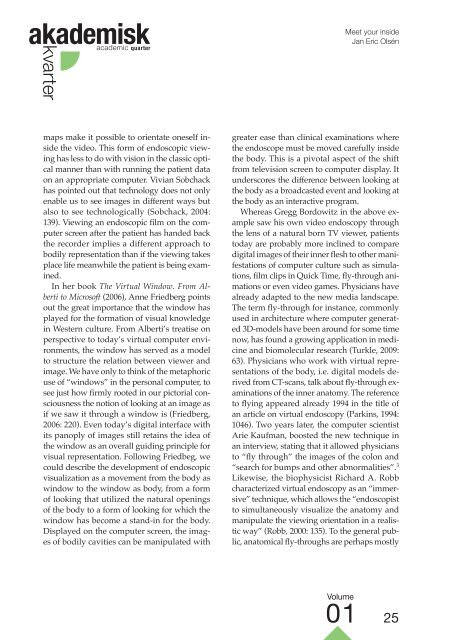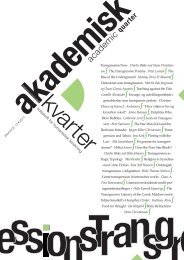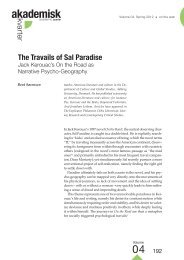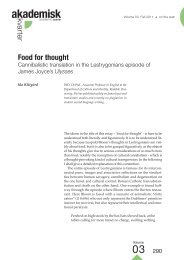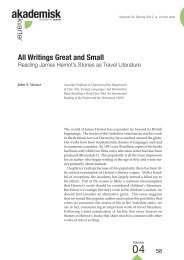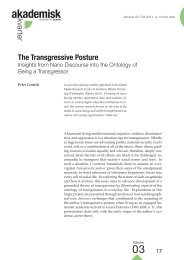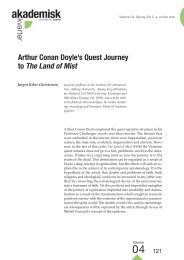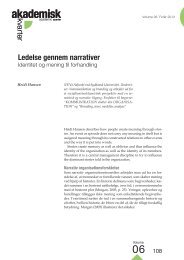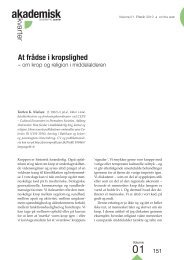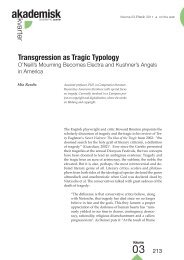Academic Quarter - Akademisk kvarter
Academic Quarter - Akademisk kvarter
Academic Quarter - Akademisk kvarter
Create successful ePaper yourself
Turn your PDF publications into a flip-book with our unique Google optimized e-Paper software.
akademiskacademic quarter<strong>kvarter</strong>Meet your insideJan Eric Olsénmaps make it possible to orientate oneself insidethe video. This form of endoscopic viewinghas less to do with vision in the classic opticalmanner than with running the patient dataon an appropriate computer. Vivian Sobchackhas pointed out that technology does not onlyenable us to see images in different ways butalso to see technologically (Sobchack, 2004:139). Viewing an endoscopic film on the computerscreen after the patient has handed backthe recorder implies a different approach tobodily representation than if the viewing takesplace life meanwhile the patient is being examined.In her book The Virtual Window. From Albertito Microsoft (2006), Anne Friedberg pointsout the great importance that the window hasplayed for the formation of visual knowledgein Western culture. From Alberti’s treatise onperspective to today’s virtual computer environments,the window has served as a modelto structure the relation between viewer andimage. We have only to think of the metaphoricuse of “windows” in the personal computer, tosee just how firmly rooted in our pictorial consciousnessthe notion of looking at an image asif we saw it through a window is (Friedberg,2006: 220). Even today’s digital interface withits panoply of images still retains the idea ofthe window as an overall guiding principle forvisual representation. Following Friedbeg, wecould describe the development of endoscopicvisualization as a movement from the body aswindow to the window as body, from a formof looking that utilized the natural openingsof the body to a form of looking for which thewindow has become a stand-in for the body.Displayed on the computer screen, the imagesof bodily cavities can be manipulated withgreater ease than clinical examinations wherethe endoscope must be moved carefully insidethe body. This is a pivotal aspect of the shiftfrom television screen to computer display. Itunderscores the difference between looking atthe body as a broadcasted event and looking atthe body as an interactive program.Whereas Gregg Bordowitz in the above examplesaw his own video endoscopy throughthe lens of a natural born TV viewer, patientstoday are probably more inclined to comparedigital images of their inner flesh to other manifestationsof computer culture such as simulations,film clips in Quick Time, fly-through animationsor even video games. Physicians havealready adapted to the new media landscape.The term fly-through for instance, commonlyused in architecture where computer generated3D-models have been around for some timenow, has found a growing application in medicineand biomolecular research (Turkle, 2009:63). Physicians who work with virtual representationsof the body, i.e. digital models derivedfrom CT-scans, talk about fly-through examinationsof the inner anatomy. The referenceto flying appeared already 1994 in the title ofan article on virtual endoscopy (Parkins, 1994:1046). Two years later, the computer scientistArie Kaufman, boosted the new technique inan interview, stating that it allowed physiciansto “fly through” the images of the colon and“search for bumps and other abnormalities”. 3Likewise, the biophysicist Richard A. Robbcharacterized virtual endoscopy as an “immersive”technique, which allows the “endoscopistto simultaneously visualize the anatomy andmanipulate the viewing orientation in a realisticway” (Robb, 2000: 135). To the general public,anatomical fly-throughs are perhaps mostlyVolume01 25


